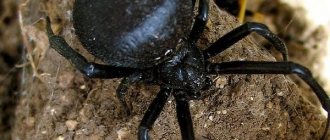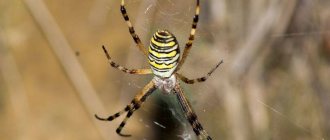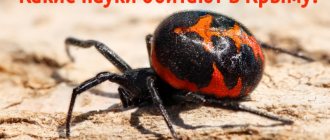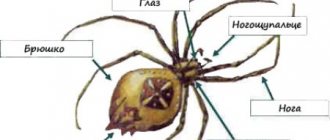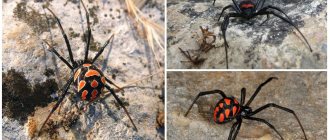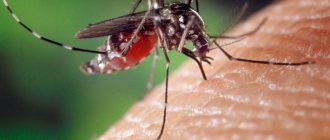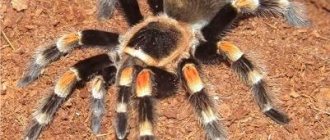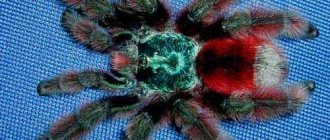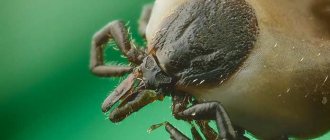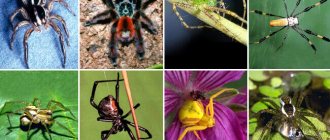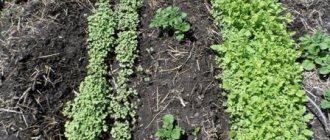The unique climate and landscape of the Crimean peninsula has always attracted tourists. Some people prefer to relax in comfortable rooms and only occasionally go on walks to explore the surrounding area. Others, like the heroes of the film “Three Plus Two,” blithely climb away from civilization and enjoy sandy beaches, mountain landscapes or steppe expanses around the clock. However, not everyone knows that the spiders of Crimea can pose a serious threat to humans and getting to know them can end very badly, even leading to death.
On a note! The subtropical Crimean climate is a favorable environment for the development of poisonous arthropods. With the onset of abnormal heat, they become more active. Every year, dozens of people are admitted to Crimean hospitals after being bitten by spiders.
How many species of spiders live in Crimea
Spiders are one of the most common and numerous orders, both among arachnids and among animals. There are more than 43,000 varieties known in the world. In comparison with this figure, the number of spider species in Crimea looks modest - about 500 and about 100 on the Kerch Peninsula. Among them are haymakers, orb weavers, eresids, atipuses, and theridiids.
Many of the representatives of arachnids are quite harmless creatures that weave original trapping nets. Often they themselves become victims of the pelopeia wasp, which feeds them to its larvae, or riders who use the spiders as an incubator for breeding.
There are only 4 species of dangerous spiders in Crimea. But meeting even one single specimen can ruin your entire vacation.
Important! If you notice a spider crawling on your clothes or body, you need to gently flick it off with a snap of your finger. Do not under any circumstances try to crush it.
The most dangerous spiders of the peninsula
Dangerous spiders of Crimea are the tarantula, karakurt, salpuga and argiope. They mostly live in wild, natural environments. People visit a person’s home extremely rarely, but such cases cannot be ruled out.
Why is a karakurt bite dangerous?
The neurotoxic venom begins to act almost at the moment of the bite. In this case, the place where the skin is damaged and the poison enters the body quickly turns red and hurts. As a result of damage to the nervous system, severe muscle pain appears. It starts with the calf and abdominal muscles. After 10–20 minutes it covers the entire body. After this, severe dizziness develops, breathing becomes difficult, profuse sweating, trembling, shortness of breath, nausea, etc. occur. If medical assistance is delayed, the condition is aggravated by mental reactions, such as depression or painful agitation. In especially severe cases, clouding of consciousness and delirium occurs. Antikarakurt serum is required for treatment. However, there are other drug treatments for black widow poisoning, but they are less effective.
It's not just people who die from black widow bites. They are especially dangerous for camels, horses and cows. Sheep, goats and pigs are practically not affected by spider venom.
Karakurt - a poisonous inhabitant of Crimea
The karakurt is recognized as the most dangerous representative of spiders. It feeds on insects. Favorite habitats are rodent burrows, from which the spider easily expels the inhabitants. Even if the mouse decides to resist the karakurt, it instantly dies from its bite. Also settles between stones, in rock cracks. It places its trapping nets in the grass, in the steppes and even in summer cottages. From Turkic the name “karakurt” is literally translated as “black worm”; a photo of the dangerous spider of Crimea is presented above.
What does the most dangerous spider in Crimea look like:
- Sexually mature females are rich black in color with a glossy sheen, up to 2 cm long.
- The length of males does not exceed 7-8 mm.
- Juveniles and males have 13 red spots on the abdomen. Sometimes they are framed with a white border.
- Two pairs of eyes help to navigate well during the day and at night.
- Random networks are located mainly near the ground.
Karakurts are very prolific. Periodically, at intervals of 10-12 or 25 years, there is a massive outbreak of population growth. They spend winter time in cocoons, several of which are suspended in nests. In mid-spring, the young generation appears and is carried away on the web by the wind. At the end of June, having become sexually mature, females and males look for shaded places and weave nets for mating.
Interesting! Due to the bloodthirstiness of the female during mating, the karakurt is also called a black widow. The mating games of the female are very peculiar - at the end of the process, she eats the male. The female has an excellent appetite: her network for mating can simultaneously contain up to 5 candidates.
The males' life cycle ends in mid-July. After mating, females look for new places, weave a network and lay offspring. After the last laying of eggs they die.
How karakurts bite
Representatives of the black widow genus are not characterized by aggressiveness towards humans. Only if they sense danger do they defend their lair - only in emergency cases are they able to attack people. Most often, this type of spider in Crimea bites accidentally. This is due to the peculiarity of their reflexes. When pressed on the abdomen, they release poison; for this reason, a spider crawling on the body should not be slammed, but carefully thrown off.
The greatest threat to humans is the female karakurt, while males, due to their small size, are not able to bite through human skin
On a note! After picnics or trips to nature, it is recommended to inspect things, as spiders can easily get into them. It is best to walk through thickets of grass in closed high shoes, and to work in summer cottages and fields with gloves.
The concentration of poisonous components in karakurts is 15 times higher than in a rattlesnake. This feature is due to the fact that spiders wage a constant fight against rodents and other small mammals, and to neutralize them a strong poison is needed. In humans, the probability of death after a bite is 2-4%. The poison has a neuroparalytic effect.
Symptoms of a karakurt bite:
- the appearance of severe burning pain, which intensifies and spreads throughout the body within 15 minutes;
- difficulty breathing;
- dizziness, possible bluish discoloration of the skin on the face;
- disturbances of heart rhythm and kidney function;
- cramps, muscle spasms in the abdominal area;
- depressive state, the appearance of a feeling of irresistible melancholy and fear of death.
On a note! The sensations of the bite field depend on the person’s pain threshold. There are cases when people in a dream did not notice at all that they had been bitten by a spider.
What to do if you are bitten by a karakurt:
- The most effective way to eliminate the consequences of a bite from the most dangerous spider in Crimea is to administer a serum. However, it is not always available at medical centers. In its absence, an intravenous injection of potassium manganese or calcium gluconate is administered. The need for a second injection is determined by the condition of the victim.
- In the field, the cauterization method, which was developed by Marikovsky, is used. Immediately after the bite, in order to neutralize the effect of the poison, 3 matches are applied to the wound (heads to the wound), and the fourth is set on fire. High temperature destroys the protein structure of the poison and thereby avoids poisoning the body.
Attention, black widow
“Black Widow” is the name of the American variety of this spider. But the Crimean one is no better. The name explains not so much the female’s habit of snacking on her husband after mating (many varieties of arachnids do this), but rather the real danger to humans.
Karakurt (Latrodectus tridecimguttatus) is the scientific name of this creature. Translated: “black worm.” You should only be afraid of spiders - the males are small, often cannot bite through the cover, and they have little poison. The female is an awkward-looking creature with a body up to 2 cm long, and the lion’s share falls on a black abdomen with or without bright red spots. The remaining parts of the spider are pure black, glossy. It lives in burrows and places its nets low above the ground.
Karakurts are the most poisonous spiders living in Crimea. Their poison is similar to that of rattlers, only 15 times stronger. The mortality rate is, of course, lower - the dose is not the same. But after the bite the following appear:
- pain (in the affected area and throughout the body);
- convulsive conditions;
- heartbeat disturbances;
- difficulty breathing;
- disorders of the kidneys;
- dizziness;
- cyanosis (blueness of the face);
- depression, panic attacks;
- abdominal cramps.
You cannot self-medicate if you are stung by a karakurt - rush to the doctor as quickly as possible. The optimal treatment option is the introduction of a special serum (produced only in Uzbekistan, costs about $1,000 per dose). If it doesn’t turn out to be there, Crimean doctors know alternative options.
Many people are also afraid of salpugs - these are scary light (sometimes white) creatures with huge jaws. You should be afraid of them, but the salpuga is not a spider, but a phalanx (something between spiders and). But in general, you need to carefully look around and always have at least diazolin with you, and better yet, diphenhydramine. We hope that our article will help you avoid troubles associated with poisonous spiders in Crimea. In conclusion - an interesting video, enjoy watching!
Poisonous spiders of Russia. There are few of them, but they exist! It’s better to know these dangerous “comrades” by sight!
Russia is a country of limitless diversity of flora and fauna. Just imagine: our country is home to about 1070 species, 40 varieties and 30 families of spiders alone! But, unfortunately, no matter how beautiful and unusual they are, not all spiders in Russia are safe for humans. What arthropods should you be wary of, and what should you do if a dangerous encounter could not be avoided?
The most dangerous spider that lives in our homeland is the karakurt. It is also called the steppe spider or. The animal looks quite bizarre: the deep black body is decorated with thirty bright red dots on the upper side of the abdomen. As the spider matures, the spots disappear and the body acquires a rich black color with a characteristic shine. Karakurt can be found in the Crimea, in the south of the Urals, in the Moscow region and in the North Caucasus.
The bite of this arthropod causes unbearable pain throughout the body, causes severe poisoning, which, if not treated correctly, can lead to the death of the victim. The most dangerous are female karakurts.
What to do if a bite occurs? Within a few minutes, you need to cauterize the affected area with two or three matches. As soon as possible, the victim must be taken to the hospital, where he will stay for a couple of days.
Next in our ranking of dangerous spiders is the South Russian tarantula, which is also called the Mizgir. This animal has a furry body, up to 30 mm long. Its abdomen is brownish-red in color, and its body is darker in color. They live in the steppe and semi-desert territories of our country; they have been spotted in the Saratov, Oryol and other regions. Tarantulas have a black cap, which distinguishes them from other representatives of the dangerous animal world. The bite of these animals is not fatal, but causes a complex allergic reaction.
Another representative of poisonous spiders in Russia is the eight-legged Cheiracanthium. This spider is quite peaceful and bites only in defense. It has an oblong body of light yellow color. The place of residence of this arthropod is the North Caucasus, but it can also be found in other parts of our country.
The least dangerous, but also poisonous, are web spiders. They belong to the subspecies of crosses. They got their name due to the cross-like pattern on their abdomen. Networts are members of the orb weaver family; their webs are large and radial. The body of these animals is relatively small (no more than 25 mm in length) and has different shades. Like Cheiracanthiums, networts attack only if they are threatened. An arthropod's bite can cause an infection, so if necessary, consult a doctor.
Tarantula is the largest spider in Crimea
The very name of the large spider of Crimea inspires fear, and the photo can even provoke arachnophobia. Tarantulas belong to the large family of wolf spiders. The size of an adult reaches 3.5 cm. The gray shaggy body and the same shaggy legs are the “calling card” of the spider.
On the Crimean peninsula, you can find tarantulas in dry areas and steppes. During the daytime, they take refuge in underground vertical burrows, the depth of which can reach 60 cm, waiting out the heat. At night they go hunting. Caterpillars, grasshoppers, flies, moths, mole crickets and other small insects become victims of spiders. Unlike most arachnids, the tarantula does not weave trapping webs. Seeing the victim, he quickly catches up with it on his long furry paws and injects his poison into it.
Interesting! Females show amazing care for their offspring. After mating at the end of summer, the female goes into a burrow, lays eggs, and meticulously weaves them around with a web. She carries the formed cocoon with her everywhere before the appearance of the young. The newborns that appear remain on the female’s abdomen for some time.
Crimean spiders, which belong to the “South Russian tarantula” species, have a distinctive brown “cap” on their heads.
Humans are of no interest to the giant spiders of Crimea. On the contrary, having heard vibrations from human steps, it tries to hide away. It can bite only in case of self-defense. The sensations after a bite are comparable to the bite of 2 bees or one hornet. Allergic reactions to tarantula venom may occur, which are manifested by fever, nausea, and pain in the muscles.
Previously, in Italy and Spain, in order to neutralize spider venom, they began to dance frantically. Now it is enough to treat the wound with brilliant green or an alcohol solution, apply a cold compress and provide the victim with peace.
Tarantula. Crimean tarantula. Tarantula bite, help with a bite.
is the common name for several species of large spiders belonging to the wolf spider family. Tarantula is an invertebrate animal. Its body, consisting of two parts - the cephalothorax and abdomen, is covered with small hairs. Tarantulas are the largest spiders living in Ukraine, the size of large individuals reaches 4 cm. The spider is colored brown-gray-black, and those that have not shed for a long time have a red tint. Very often, other large spiders, such as tarantulas, are mistakenly called “tarantulas.”
Crimean tarantula. Tarantula habitat.
The name tarantula comes from the Italian city of Tarantum. People in the Middle Ages believed that anyone bitten by a spider would become ill with a terrible disease - tarantism. It was expressed by complete indifference to everything and always ended in death. The only means of salvation was the wild dance of the tarantella. To get rid of the disease, you had to dance until you were completely exhausted.
Tarantulas love dry areas such as steppes or deserts. In Ukraine, the tarantula is found in the steppe part of Crimea. Tarantulas are nocturnal predators. During the day, they take refuge in vertical burrows up to 50 cm deep. Sometimes they choose natural shelters for shelter - various cracks and faults. To protect themselves from frost in winter, tarantulas deepen their burrow and bury the entrance.
At night, spiders come to the surface and begin hunting. The tarantula's diet consists of various insects, smaller in size than the spider itself. Tarantulas do not weave trapping nets; they use the web only to build an egg cocoon and cover the walls of the burrow.
Tarantula bite.
All tarantulas are poisonous, but this does not mean that they are particularly dangerous to humans.
Their venom is enough to paralyze a small animal, but for people a tarantula bite is equivalent to a wasp sting, well, maybe a little stronger. Swelling appears at the site of the bite, the venom causes pain and numbness, and the temperature often rises. Only a severe allergic reaction can lead to death.
Tarantulas never attack anything larger than themselves. And from this it follows that he will not bite a person first, only in case of self-defense, for example, when you accidentally pressed him.
First aid for a tarantula bite.
- Wash the bite area thoroughly with plenty of soapy water.
- Apply a tourniquet to the bitten limb and immobilize it as much as possible.
- Apply ice to the bite site.
- Drinking plenty of fluids is recommended. Then some of the poison will be eliminated faster in the urine.
- For adults, you can give aspirin or acetaminophen. It is better to give paracetamol to children.
- If possible, crush the tarantula and apply blood to the bite area. The fact is that his blood contains an antidote to his own poison.
- If an allergic reaction occurs, it is better to take the victim to the hospital as soon as possible.
Photo of the tarantula:
Externally, in our usual understanding, local spiders are similar to: karakurt, tarantula, agriope and salpuga (phalanx). But! There are also other dangerous arachnids here - ticks and even the Crimean scorpion - yes, all this is one class of arachnids. The ringed scolopendra is also found in Crimea. Stinging insects include the hornet, wasp, gadfly and the ubiquitous mosquitoes.
Solpuga - an inhabitant of the southern coast
Salpugs, also known as phalanges, are another interesting species of spider in Crimea, listed in the Red Book. They live in arid areas, mainly in the foothills of the southern part of the peninsula. They are active at night. The body length can reach 5-7 cm. The entire body and paws are covered with hairs. The forelimbs resemble tentacles. They feed on insects, small lizards, and scorpions. The structure of compound eyes, which provide instant reaction and visibility in the dark, makes salpugs excellent hunters.
Salpugs are very mobile, run well and even jump high
In South Africa, such arachnids are called barbers. This name stuck due to the developed strong front tentacles, through which they are able to deprive a person of hair on his head, as well as animal hair. Spiders line the bottom of their nests with “cut” hair.
Small individuals cannot harm humans, since not yet fully formed chelicerae are not able to bite through the skin. But a meeting with an adult spider does not bode well. Their chelicerae are equipped with teeth and their bites are very painful. And although the spider does not inject venom when it bites, its jaws retain the remains of previous victims, which can penetrate the wound and cause rotting. It is noteworthy that salpugs are not afraid of people and can easily join gatherings near the fire.
Let's put a cross: biting cross spiders
In many spiders, females are dangerous to humans - they are significantly larger than males (they are simply unable to bite through the skin). This is also true for cross spiders. There are several varieties of them (common Araneus diadematus, diamond-shaped), but they are all similar in habitat, appearance and influence on people.
Krestoviki weave trapping nets and hang them between trees and bush branches. All of them are not rare; many have seen them. A distinctive feature is a light pattern like a cross on the abdomen. These are large spiders - a female, hanging with her legs spread out in the web, can reach 4 cm in “diameter”. They feed on insects.
A cross bite is not dangerous, but can be painful and cause significant local inflammation (up to and including slight necrosis of the tissue around the wound). No special treatment is needed - just lubricate the area with anti-inflammatory agents. If the manifestation is severe, you can take an antiallergen.
This is interesting: Mount Perchem in Sudak (Crimea): photo, how to get there, on the map, description
Argiope - the most original spider of Crimea
The color of the spider's abdomen is very similar to that of a wasp. Alternating yellow and white stripes give the arachnid an unforgettable appearance. This representative is by no means uncommon in Crimea and can be found in the steppe and forest zones.
Like the black widow, the female Argiope devours her suitors
Because of the striped color, many more names appeared: zebra, wasp spider. Body dimensions do not exceed 1.5 cm. Peak activity occurs in the evening and at night. Spiders weave webs of complex design. At the same time, it takes them no more than an hour to create a fishing net. The individual itself is located in the center of the structure and hangs head down. Grasshoppers, locusts, and grasshoppers are the spider’s favorite delicacies.
An argiope bite does not pose a mortal danger to humans. The affected area may develop suppuration, abscesses, and in the worst case, the development of tissue necrosis. People prone to allergies may experience allergic reactions to spider venom.
Important! No matter what spider bites you, you should never apply a tourniquet. Poor circulation can lead to limb necrosis. It is also forbidden to cut wounds and incisions near them.
How to protect yourself while hiking. Simple rules
Be especially careful in the evening and at night, when arthropods are most active. Try to walk in closed shoes. When collecting wood for a fire, first turn over branches or sticks with your feet to make sure that no one is under them.
Boots. Try not to leave your boots outside the tent overnight. If you don't feel comfortable with them in your tent, hang them from a tree or tuck a sock into the top. Be sure to shake them out in the morning. Tent. Treat the entrance to the tent with repellent. At any time of the day, the entrance to the tent must be closed with a zipper. Sleeping bag. Before going to bed, shake out your sleeping bag. Cloth. If clothes have been left outside for some time, it is also a good idea to shake them out. Medicines. Carry antihistamines with you in case of an allergic reaction from a bite.
Now you know about all the potentially dangerous inhabitants of Crimea. If reasonable precautions are taken, the risk of threat to life and health is minimal.
Do not forget that the most poisonous on the Crimean peninsula is karakurt, the poison of which is several times stronger than the poison of a rattlesnake. The bite of other arachnids in Crimea is not fatal and does not pose a serious danger to a healthy person, but allergy sufferers, children and people with weakened immune systems remain at risk.
Emergency care for snake bites and farts. Video from Dr. Komarovsky
Black and green spiders, not dangerous to humans
Considering the types and names of spiders that do not cause any harm to humans, we decided to focus on the following families:
- brownies;
- crosses;
- horses;
- side walkers.
The brownie is a forest spider that has been living in human homes for many hundreds of years. These yellow-brown individuals feed on domestic insects, so they can be called apartment orderlies. Of course, the very presence of spiders with a skull on their back does not really advertise the cleanliness of their owners. On the other hand, there is a popular belief that a brownie is a sign of financial well-being.
The cross spider is a black spider with white stripes on its back, forming something like a cross. Often the spots are rather yellowish. The males of these black and white spiders are much smaller than the females. They have the ability to weave large nets and a strong appetite. In one sitting, an individual can eat up to eight insects. For humans, a spider with white spots on its back is completely safe. The maximum harm from them is a slight burning sensation for a short time.
The jumper is a black spider with white stripes, which, however, can have almost any color. The special structure of the body and legs, as well as a well-developed internal hydraulic system, allow it to jump long distances and climb vertical smooth surfaces. Such a spider with a red belly is the worst nightmare of many insects. The horse can weave a cocoon from silk thread for the “maternity hospital” of its female. Perhaps the only one of all spider species that does not eat its own kind. Such nobility deserves special mention.
The sidewalker is a spider with a green back that can change colors depending on the circumstances. For the active hunter that he is, this is a big help. Just now there was a very noticeable spider with a white belly - suddenly it disappeared. Where? Take a closer look and you can barely make out a spider with a green abdomen among the plants. And so on. This white-backed spider, which can turn yellow when necessary, got its name because of the way it moves. Outwardly, it resembles the gait of a crab.
Regardless of who bit you - a poisonous tarantula or a harmless spider with black and white legs - you should immediately disinfect the affected area of skin. If an accident occurs in nature and a person immediately becomes ill, you need to see a doctor as soon as possible. In such cases, the alarm is never false. You can get more interesting information about the modern classification of spiders on the website of our company in Moscow.
I think these creatures could easily destroy the entire population of our planet. They are smart, cunning, resourceful and incredibly poisonous. Having a large number of limbs, unlike humans, these creatures are able to move faster. They are also able to weave skillful traps into which each of us fell. But such seemingly perfect plans to take over the world fall apart due to their size. Nature decided that they should be no larger than a human palm.
Can you guess who we'll be talking about in this top?
That's right, about spiders. Quite dangerous creatures, aren't they? People are very lucky that these creatures are so small in size. After all, even if they were at least the size of an ordinary cat, I think there are few who would remain on earth now except these poisonous arthropods.
Spiders were even defined as a separate class based on phenotype. However, their almost unique properties, I think, also deserve this separate group.
Now let’s prove our thoughts with facts. Top 10 most dangerous and poisonous spiders on the planet!
It is also called golden or golden, although judging by the consequences of meeting it, it is not such a “golden” spider. He lives mainly in Europe. Its size is very small, up to one centimeter in length. These arthropods build their houses like a bag, elongated like a pipe. Sometimes they can hide inside the house. Very often their bites are misdiagnosed - they are mistaken for the bite of a brownish recluse spider. These bites are always clinically dangerous. After them, severe pain appears and a necrotic wound develops, of course not as quickly as in a recluse spider. A yellow spider may bite only because it senses danger. Therefore, if you are planning a trip to European countries, be sure to remember what the Poisonous Spider Sak looks like, and do not anger him when you meet him.
"Relationship" with a person
Although the spider with yellow stripes on its back is classified as poisonous, it does not pose a great danger to humans. Firstly, he is afraid of people and will never attack first; rather, he will run away or fall to the ground and pretend to be dead. Secondly, argiope is not able to bite through human skin to inject poison.
But if you take a wasp spider with your bare hand, an unpleasant and rather painful bite is guaranteed. The redness and itching of the stung area goes away quite quickly. For allergy sufferers, the reaction can be more violent and unpredictable - from severe swelling of the bite site to increased temperature and swelling of the respiratory tract.
Therefore, it is better to stay away from the beautiful and insidious arthropod. It has no place at all in the garden or flower garden. But if you meet him in the forest, let him live!
Video about the wasp spider:
The black fathead is sometimes called the ladybug spider. It really resembles this bright insect: against the red or orange background of its abdomen, four black spots with a white border stand out.
However, only the male looks so impressive. The female black fathead, although larger, is less brightly colored. It is usually velvety black, sometimes with yellow elements on the front.
Reproduction of Argiope
The mating period occurs immediately after the female moults, which precedes puberty. At this time, the covers of its chelicerae are still soft. Everyone knows the sad fate of the male karakurt spider (black widow). It is simply eaten by the female immediately after mating, thereby increasing the chances of survival of her offspring. In the case of agriope, we observe a similar situation.
In July, at the edges of the web, as a rule, you can see a male waiting for the last moult of the female. As mentioned above, one pair of its limbs is transformed into bulbs. During the fertilization process, one of them falls off. If the male manages to hide from the female, then he can mate with another female.
Argiope Brünnich lays its eggs in a large cocoon (pictured above), which resembles the structure of a plant capsule. It is located near the web. The spider is fertile, the number of eggs laid at one time reaches several hundred. At the beginning of autumn, young spiders are born. They leave their cocoon in a rather peculiar way. Young individuals climb to heights, then release a long thread and, with a gust of wind, are carried away with it. Thus, the species spreads across natural biotopes. The full life cycle of this type of spider is one year.
In the next photo you can see spiders just emerging from the cocoon.
Low-venomous spiders
Since non-venomous spiders do not exist in nature, there are none in Crimea either. There are species that, when large in size, are not dangerous to humans, since their venom is too weak or the chelicerae cannot bite through the skin. Some spiders, for example the haymaker spider or the house spider, are completely unable to catch human skin. Small spiders sitting in the grapes hunt insects in the grapes that have decided to feast on the berries. Since Crimea is one of the regions where grapes are grown on an industrial scale, such grape spiders have freedom there.
These little spiders may scare only arachnophobes. But large spiders with striking bright colors are able to alert any person who is not familiar with them. Such spiders in Crimea include:
- Argiope Brünnich;
- Argiope lobata;
- cross spider.
Because of their coloration, argiopes are considered dangerous spiders. The cross can be intimidating only by its size.
Argiope bruennichi
Argiope is also called the wasp spider because of the color of its abdomen. Argiopes are classified as orb-weaving spiders that build webs on trees and shrubs.
Argiope Brünnich
The spiders are small in size: females up to 1.5 cm, males up to 5 mm. In both sexes, the abdomen is colored with black and yellow transverse stripes. But the female has a rounded abdomen. The male's body shape is indeed very similar to a small wasp. These are arthropods common to the Crimea, but the population is not as large as that of the crosses.
The bite of the argiope is quite painful. But it causes only short-term pain and local irritation at the bite site.
Argiope lobata
Another species that is found in Crimea in small quantities. When you look at the spider, you get the impression that it is dressed in a hard chitinous shell. But this is deceptive. In fact, Argiope lobata has the same soft abdomen as other spiders. It looks like an armored monster due to the silver-white color of its abdomen, “equipped” with 6 deep notches on the sides. The color of the notches can range from dark to orange.
The female’s body size is up to 1.5 cm. Lobata builds nets on trees and bushes. The poison is not dangerous to humans, although the bite is unpleasant.
Common cross (Araneus diadematus)
The most common large spider in Crimea. You can come across his nets everywhere: from tall grass in the steppe to a tree on a Crimean yaila. Krestovik loves to settle in vineyards and gardens. There's more loot there.
Spiders of Crimea
The female's body size is 2-2.5 cm, the male's is 1 cm. The female has a large, convex egg-shaped abdomen with an exaggeratedly sharp tip. The “blunt” end of the “egg” is connected to the cephalothorax. The male has a “flattened” abdomen, elongated and narrow. The cephalothorax is round and wider than the abdomen.
The color of crosses can be yellow-white or gray-white. On the back there is a characteristic pattern in the form of a cross, for which the spiders received their name.
On a note!
The bite of the cross is weaker than that of a mosquito and is not capable of causing harm. The spider cannot even bite through the skin of a 6-year-old child, but it is able to explain to the mischievous child that there is no need to hunt funny “crusaders.” Crosses are dangerous only for people with a tendency to allergies and those suffering from arachnophobia.
The most unusual species
Nature sometimes puts spiders in such bizarre forms that you just wonder where so much imagination comes from. Here are just a few such examples.
- Spider-Peacock. It is distinguished primarily by its bright color, reminiscent of a peacock feather. The size of the individual is limited to five millimeters, so it is not easy to see. Only males have this color.
- Crab spider. Externally it resembles a crab. In addition, this unique creature can move, just like a crab, from side to side and back to front. And the ability to change color makes it invisible against the background of its habitat.
- Dolomedes. Another name for this spider is “fish”, since it lives near bodies of water and feeds on small fish, which are no larger in size than itself.
- Spider is a whip. This creature rather resembles a thin twig and is completely unlike its fellows. The species was named Colubrinus, which means serpentine. Nature created it this way for camouflage. Such a predator sits in the web, and the prey thinks that the twigs are stuck to the web and is not afraid of it at all.
Enemies of the White Karakurt
For every predator, there is a predator that can destroy the animal. Under natural conditions, even the spider described has enemies:
- sphex, a type of wasp that hunts spiders, killing them with its poison;
- ichneumon wasps lay their eggs in spider cocoons;
- hedgehogs, they are not afraid of the poison of the White karakurt, and they feed on these arthropods;
- sheep and goats, spider venom is not dangerous for them, and on pastures farm animals trample clutches of eggs and the spiders themselves. Farmers use this feature; they first drive sheep and goats to pastures, and then graze cattle there, for which the spider’s venom is deadly.
Arachnids
The arid regions of Central Asia and Africa are home to large arthropods that are often mistaken for spiders. These are salpugs. According to the tracing paper from English, they are also called. But unlike spiders, salpugs have teeth, they do not have arachnoid glands and are not poisonous.
Salpuga is a large animal capable of catching up and killing not only invertebrates, but also small lizards. The chelicerae of large salpugs are so powerful that they can bite through a human fingernail. No real spider is capable of this. Although salpugs do not have poison, their bite can be very dangerous. Particles of decaying flesh remain on the chelicerae of these arthropods. After a bite you can get blood poisoning.
Spiders cause many problems, although they are one of the most harmless and useful inhabitants of the planet. Spider lovers consider them “kittens.”
The wealth of species in the wild is simply staggering. There are over 35 thousand species of arachnids alone.
And in this article we will look at one of the amazing subspecies, allegedly similar to a wasp - Argiope bruennichi.
Read on to learn about the features of appearance, habitat, lifestyle, methods of weaving webs, reproduction, danger to humans and the possibility of keeping them at home.
Widespread species of spiders in Russia
Russian spiders are a species native to the Holarctic region and are therefore found in many regions of the northern hemisphere. Some of them have adapted to live next to humans. Many “help” gardeners clean the garden from pests, which is why they are considered country spiders.
Horses
Among the most widespread families are jumping spiders. Representatives of the family are found throughout the country. These small spiders do not pose a danger to humans. But they can scare you if they jump from an ambush. But horses prefer not to contact people. If an animal jumps out, it means something scared it. He doesn't show aggression.
Hunters
Huntsman spiders or pisaurids can be considered the second most numerous. These species belong to the forest spiders, choosing shady, damp places to live. The edge hunter can settle in a clearing or forest edge. This species prefers to ambush on grass and bushes. The rest settle near bodies of water and often wait for prey, lowering their front paws into the water.
Spiders of Russia
Funnel
This group got its name from the fact that it makes nests in the form of a spider's funnel. It includes both the harmless house spider and the rather dangerous southern cellar spider. Depending on the species, funnel-web spiders make nests:
- in the ground;
- in the forest floor;
- under stones;
- at the base of the bushes;
- in the basements of houses and woodpiles.
Orb weavers
Representatives of orb weavers are often called garden spiders. Of these, the most common spiders are cross spiders. They are often classified as garden animals, as they like to settle in gardens and parks. These spiders are widespread in central Russia and the Far East, in the south and north up to the Arctic Circle.
Synanthropic species
One of the species of the harvester family has actually become a house spider. It is no longer possible to find it in natural conditions. Due to its tendency to coexist with humanity, the haymaker spider is the most common species today. Often he travels with a person.
